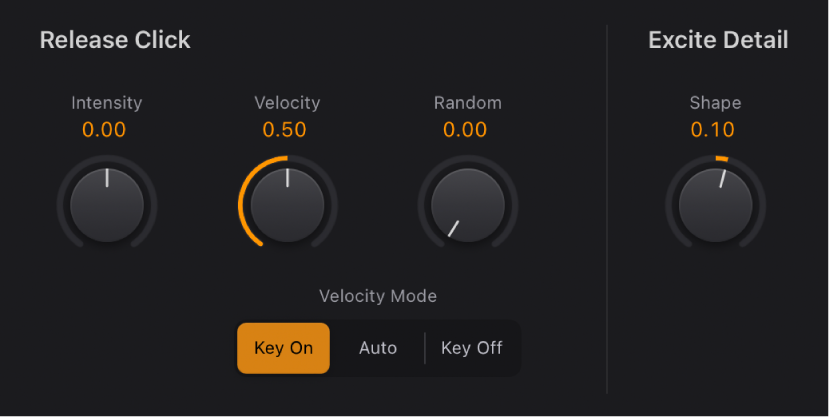Logic Pro User Guide for iPad
-
- What is Logic Pro?
- Working areas
- Work with function buttons
- Work with numeric values
-
- Intro to tracks
- Create tracks
- Create tracks using drag and drop
- Choose the default region type for a software instrument track
- Select tracks
- Duplicate tracks
- Reorder tracks
- Rename tracks
- Change track icons
- Change track colors
- Use the tuner on an audio track
- Show the output track in the Tracks area
- Delete tracks
- Edit track parameters
- Start a Logic Pro subscription
- How to get help
-
- Intro to recording
-
- Before recording software instruments
- Record software instruments
- Record additional software instrument takes
- Record to multiple software instrument tracks
- Record multiple MIDI devices to multiple tracks
- Record software instruments and audio simultaneously
- Merge software instrument recordings
- Spot erase software instrument recordings
- Replace software instrument recordings
- Capture your most recent MIDI performance
- Use the metronome
- Use the count-in
-
- Intro to arranging
-
- Intro to regions
- Select regions
- Cut, copy, and paste regions
- Move regions
- Remove gaps between regions
- Delay region playback
- Trim regions
- Loop regions
- Repeat regions
- Mute regions
- Split and join regions
- Stretch regions
- Separate a MIDI region by note pitch
- Bounce regions in place
- Change the gain of audio regions
- Create regions in the Tracks area
- Convert a MIDI region to a Drummer region or a pattern region
- Rename regions
- Change the color of regions
- Delete regions
- Create fades on audio regions
- Access mixing functions using the Fader
-
- Intro to Step Sequencer
- Use Step Sequencer with Drum Machine Designer
- Record Step Sequencer patterns live
- Step record Step Sequencer patterns
- Load and save patterns
- Modify pattern playback
- Edit steps
- Edit rows
- Edit Step Sequencer pattern, row, and step settings in the inspector
- Customize Step Sequencer
-
- Effect plug-ins overview
-
- Instrument plug-ins overview
-
- ES2 overview
- Interface overview
-
- Modulation overview
-
- Vector Envelope overview
- Use Vector Envelope points
- Use Vector Envelope solo and sustain points
- Set Vector Envelope segment times
- Vector Envelope XY pad controls
- Vector Envelope Actions menu
- Vector Envelope loop controls
- Vector Envelope release phase behavior
- Vector Envelope point transition shapes
- Use Vector Envelope time scaling
- Use the Mod Pad
- Modulation source reference
- Via modulation source reference
-
- Sample Alchemy overview
- Interface overview
- Add source material
- Save a preset
- Edit mode
- Play modes
- Source overview
- Synthesis modes
- Granular controls
- Additive effects
- Additive effect controls
- Spectral effect
- Spectral effect controls
- Filter module
- Low and Highpass filter
- Comb PM filter
- Downsampler filter
- FM filter
- Envelope generators
- Mod Matrix
- Modulation routing
- Motion mode
- Trim mode
- More menu
- Sampler
- Copyright
Vintage Clav click and excite in Logic Pro for iPad
The Release Click and Excite Detail parameters determine the string excitation, emulating the characteristics and power of the hammers striking the string and other elements that form part of the initial key strike.
Also emulated are string excitations that occur on key release. To explain, the rubber hammers of the original D6 age and decay, just like piano hammer felts. Worn out D6 units produce a distinctive “click” when a key is released. This is due to the string sticking to the rubber hammer before being released. The characteristics of this release click are part of each model and can be precisely adjusted.

Release Click parameters
Intensity knob and field: Set the level of the release click. A negative value of −1.00 eliminates the release click. To simulate an old D6, increase the value.
Velocity knob and field: Set the velocity sensitivity for the key click sound. The maximum key click level is set with the Intensity slider and the velocity mode is determined with the Velocity mode switch.
Random knob and field: Control the amount of release click level variance across the keyboard. This slider simulates the wearing of some hammers, but not others, emulating the “wear and tear” of a D6. The farther to the right the slider is moved, the greater the variation between release clicks on some keys. At the leftmost position, all keys have an identical release click level.
Velocity Mode buttons: Turn attack (Key On) or release (Key Off) velocity on or off. Turn on the Auto button to automatically detect incoming release velocity values. Received release velocity data is used to shape the sound. If no release velocity data is detected, it acts as if it is turned off.
Excite Detail parameter
Shape knob and field: Contour the attack shape, simulating the hardness of the rubber hammers in a D6. As the instrument ages, hammers wear and split, changing brightness and tone. Negative values—to the left—provide a softer attack, and positive values result in a harder attack.
Download this guide: PDF